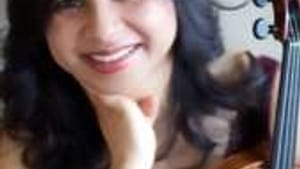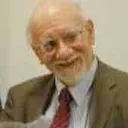Stay in the Loop
BSR publishes on a weekly schedule, with an email newsletter every Wednesday and Thursday morning. There’s no paywall, and subscribing is always free.
Bach's secret formula
Chamber Orchestra's new face

The Chamber Orchestra of Philadelphia applied two sure-fire rules to its all-Bach concert, led by violinist/conductor Adele Anthony: Keep the forces small, and put the event in the hands of a first-class musician who understands Bach's music.
The result was a concert that featured four of the best performances of Bach's instrumental music that I've heard.
Bach's orchestral suites can sound muddy and dull when they're played by a large orchestra. The Chamber Orchestra presented Bach's First Suite with 21 musicians and produced music that hit you with its brightness as soon as they launched into the grave first notes of the opening overture.
When the orchestra switched to the fast section in the middle of the overture, you could follow all the complex instrumental interactions that create the drive and variety packed into Bach's allegros.
Leading from the chair
Adele Anthony is another addition to the parade of unfamiliar faces the Chamber Orchestra has introduced to local audiences under the leadership of Dirk Brossé and his predecessor, Ignat Solzhenitsyn. This was Anthony's first visit to Philadelphia, even though she's cultivated an international reputation since she won Denmark's Carl Nielsen International Violin Competition in 1996.
Anthony led the First and Third suites from the first chair in the violin section— a common practice in Bach's day. At times I thought the orchestra might have sounded smoother had it been led by a conventional conductor. But a performance that's lively and a little rough is always better than a precision-made product that's smooth and dull.
The Chamber Orchestra presents a guest soloist with an ideal ensemble for a concert led by the first violinist. Six of the musicians were veterans from the days when this orchestra— then known as Concerto Soloists— frequently played without a conductor. Many of the other musicians had played with Solzhenitsyn when he conducted piano concertos from the keyboard.
Dances to listen to
But the leader is still responsible for tempos, instrumental balance and the overall concept behind the performance. Anthony displayed a firm grasp of the boundaries that define a successful encounter with Bach's irrepressible exuberance. In the fast section of the opening overture, for example, the orchestra maintained a high pressure pace without ever sounding frantic.
Bach's orchestral suites are collections of dances elaborated to the point that no one could possibly dance them. Anthony managed to bring out the complexities without sacrificing the underlying pulse of the dance.
The Third Suite adds trumpets and timpani to the instrumental mix and coats the hop-hop rhythms of rustic dances like the gavotte with a bright, majestic sheen. Anthony brought out the majesty but never forgot that Bach combined it with the sheer joy of people flinging their bodies around in time to music.
The weakest Brandenburg
For Bach's Second Violin Concerto, Anthony vacated the first chair and led from the soloist's position, standing in front of the orchestra. As a soloist, she held the center of the stage without dominating the orchestra. She integrated her part with the orchestra in the sections in which soloist and orchestra play together and slipped naturally into the spotlight when the solo line emerged from the orchestral mass.
The Third Brandenburg Concerto is the shortest of the six Brandenburgs and I've always felt it was the weakest. It consists of two fast movements joined by a brief improvised bridge, and it goes by so quickly that it seems like a filler compared to its stablemates. This performance, for once, endowed it with so much gusto that it felt like a full bodied member of the Legendary Six.
Anthony wisely restricted the orchestra to the minimalist forces that Bach specified: three violins, three violas and three cellos, supported by one bass and a harpsichord. The first movement leaped out of the blocks with all the bounce and drive that have earned the Fourth Brandenburg a permanent place on the Baroque hit parade. The second movement jig shot off to the races as soon as Anthony finished her 30-second version of the bridge.
Joy with complexity
One of the perennial divisions in the world of the arts is the debate between those who value art for its formal, purely aesthetic aspects and those who respond to the emotions it communicates. Bach's orchestral music sidesteps the whole issue.
Audiences like Bach's orchestral music because it's incredibly joyous, but the joy is inextricably entwined with the complexity. Bach's exuberant creativity becomes a general exuberance, transforming the technicalities of counterpoint and fugal structure into the irresistible display of joie de vivre the Chamber Orchestra offered to its audience.♦
To read responses, click here.
The result was a concert that featured four of the best performances of Bach's instrumental music that I've heard.
Bach's orchestral suites can sound muddy and dull when they're played by a large orchestra. The Chamber Orchestra presented Bach's First Suite with 21 musicians and produced music that hit you with its brightness as soon as they launched into the grave first notes of the opening overture.
When the orchestra switched to the fast section in the middle of the overture, you could follow all the complex instrumental interactions that create the drive and variety packed into Bach's allegros.
Leading from the chair
Adele Anthony is another addition to the parade of unfamiliar faces the Chamber Orchestra has introduced to local audiences under the leadership of Dirk Brossé and his predecessor, Ignat Solzhenitsyn. This was Anthony's first visit to Philadelphia, even though she's cultivated an international reputation since she won Denmark's Carl Nielsen International Violin Competition in 1996.
Anthony led the First and Third suites from the first chair in the violin section— a common practice in Bach's day. At times I thought the orchestra might have sounded smoother had it been led by a conventional conductor. But a performance that's lively and a little rough is always better than a precision-made product that's smooth and dull.
The Chamber Orchestra presents a guest soloist with an ideal ensemble for a concert led by the first violinist. Six of the musicians were veterans from the days when this orchestra— then known as Concerto Soloists— frequently played without a conductor. Many of the other musicians had played with Solzhenitsyn when he conducted piano concertos from the keyboard.
Dances to listen to
But the leader is still responsible for tempos, instrumental balance and the overall concept behind the performance. Anthony displayed a firm grasp of the boundaries that define a successful encounter with Bach's irrepressible exuberance. In the fast section of the opening overture, for example, the orchestra maintained a high pressure pace without ever sounding frantic.
Bach's orchestral suites are collections of dances elaborated to the point that no one could possibly dance them. Anthony managed to bring out the complexities without sacrificing the underlying pulse of the dance.
The Third Suite adds trumpets and timpani to the instrumental mix and coats the hop-hop rhythms of rustic dances like the gavotte with a bright, majestic sheen. Anthony brought out the majesty but never forgot that Bach combined it with the sheer joy of people flinging their bodies around in time to music.
The weakest Brandenburg
For Bach's Second Violin Concerto, Anthony vacated the first chair and led from the soloist's position, standing in front of the orchestra. As a soloist, she held the center of the stage without dominating the orchestra. She integrated her part with the orchestra in the sections in which soloist and orchestra play together and slipped naturally into the spotlight when the solo line emerged from the orchestral mass.
The Third Brandenburg Concerto is the shortest of the six Brandenburgs and I've always felt it was the weakest. It consists of two fast movements joined by a brief improvised bridge, and it goes by so quickly that it seems like a filler compared to its stablemates. This performance, for once, endowed it with so much gusto that it felt like a full bodied member of the Legendary Six.
Anthony wisely restricted the orchestra to the minimalist forces that Bach specified: three violins, three violas and three cellos, supported by one bass and a harpsichord. The first movement leaped out of the blocks with all the bounce and drive that have earned the Fourth Brandenburg a permanent place on the Baroque hit parade. The second movement jig shot off to the races as soon as Anthony finished her 30-second version of the bridge.
Joy with complexity
One of the perennial divisions in the world of the arts is the debate between those who value art for its formal, purely aesthetic aspects and those who respond to the emotions it communicates. Bach's orchestral music sidesteps the whole issue.
Audiences like Bach's orchestral music because it's incredibly joyous, but the joy is inextricably entwined with the complexity. Bach's exuberant creativity becomes a general exuberance, transforming the technicalities of counterpoint and fugal structure into the irresistible display of joie de vivre the Chamber Orchestra offered to its audience.♦
To read responses, click here.
What, When, Where
Chamber Orchestra of Philadelphia: Bach, Suite No. 1 in C minor; Violin Concerto No. 2 in E major; Brandenburg Concerto No. 3 in G minor; Suite No. 3 in D major. Adele Anthony, violinist and conductor. November 4, 2012 at Perelman Theater, Kimmel Center, Broad and Spruce Sts. (215) 545-5451 or www.chamberorchestra.org.
Sign up for our newsletter
All of the week's new articles, all in one place. Sign up for the free weekly BSR newsletters, and don't miss a conversation.

 Tom Purdom
Tom Purdom